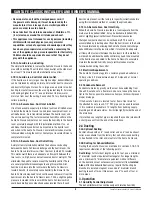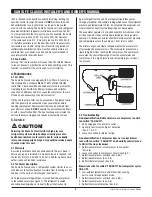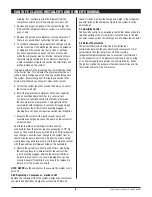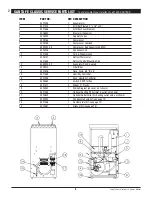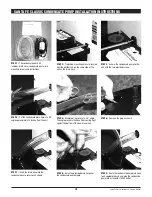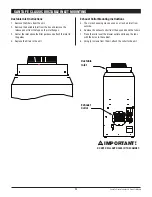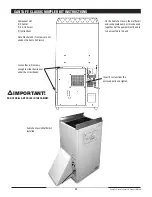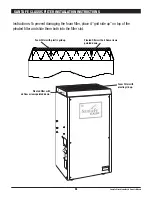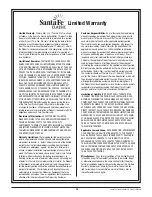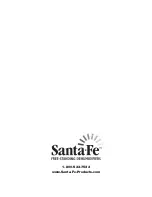
• Never operate a unit with a damaged power cord. If
the power cord is damaged, it must be replaced by the
manufacturer, its service agent, or a similarly qualified
person in order to avoid a hazard.
• Do not obstruct the air intake and exhaust. Maintain a 1 ft.
(.3 m) clearance around the air intake and exhaust.
• This appliance is not intended for use by persons (including
children) with reduced physical, sensory or mental
capabilities, or lack of experience or knowledge, unless they
have been given supervision or instruction concerning the
use of the appliance by a person responsible for their safety.
Children should be supervised to ensure that they do not
play with the appliance.
2.1A In humid area, no ducting.
The simplest installation is to place the Santa Fe Classic in the humid
area with no ducting. The air inlet on top and outlet on the side must
be at least 1’ from walls and other obstructions to air flow.
2.1B In humid area, duct inlet and/or outlet.
If the humid are is very large or has high ceilings, dehumidification
can be improved by adding an inlet and/or outlet duct to circulate
and destratify stagnant areas. For a large area, add inlet or outlet
ducting to create flow across the area’s greatest length. For areas
with ceilings higher than 12’, use an inlet duct to draw warm,
moist air from near the ceiling. See section 2.4 for attaching duct
collars & ducting.
2.1C In A Remote Area, Duct Inlet & Outlet.
It is often desirable, especially in billiard rooms and finished areas,
to install the Santa Fe Classic in an adjacent equipment room or
unfinished area. Air is transferred between the humid room and
the unit via ducting. The factory mounted humidity control on the
Santa Fe Classic cabinet may not sense the humidity in the humid
room accurately enough with this installation method. If so, an
additional humidity control can be mounted in the humid room
and wired to the Santa Fe Classic. Local electrical codes must be
followed when wiring the control. Contact your local electrician to
complete this install.
2.1D In A Remote Area, Duct Outlet Only.
A simpler remote installation method than above uses ducting
between the Santa Fe Classic discharge and the humid room; the
Santa Fe Classic inlet draws air from the room in which it’s located.
This works well if there is an adequate air flow path between the
two rooms; i.e. high door undercut, louvered door or wall grill. This
eliminates the need to remote mount the humidity control. There
are several potential disadvantages to using this method. First,
humid air is drawn into the room where the Santa Fe Classic is
located. Second, to accurately sense humidity, the blower in the
Santa Fe Classic may need to run continuously to draw air from the
humid room into the Santa Fe Classic room. Third, a slight negative
pressure is created in the room with the Santa Fe Classic which
could back draft open combustion devices located there. If such
devices are present, call the factory for specific instructions before
using this installation method or consider the option below.
2.1E In A Remote Area, Duct Inlet Only.
When the Santa Fe Classic is located in a room separate from the
main area to be dehumidified, it may be desirable to dehumidify
and/or slightly pressurize that room. Pressurization assures
that open combustion devices do not back draft. This can be
accomplished by installing a duct from the humid room to the Santa
Fe Classic inlet and by allowing the Santa Fe Classic to discharge
dehumidified air into the room in which it’s located. An adequate
air flow path must exist between the two rooms for this method to
work well. An additional humidity control may need to be mounted
in the humid area and wired to the Santa Fe Classic to accurately
maintain the desired humidity. Local electrical codes must be
followed when wiring the control.
2.2 Electrical Requirements
The Santa Fe Classic plugs into a common grounded outlet on a
15 Amp circuit. It draws between 6 and 7 Amps under normal
operating conditions.
2.3 Condensate Removal
Condensate drains by gravity via the clear hose extending from
the unit. Route hose to a floor drain. Use care to keep the hose as
flat to the floor as possible. Excessive humps or kinks will prevent
proper drainage.
If the Santa Fe Classic is located too far from a floor drain for
the attached hose to reach, 1/2" PVC pipe can be used to extend
it. It is commonly available in 10’ lengths from building supply,
plumbing and hardware stores. It will slide tightly inside the end of
the drain hose.
If more than one length of pipe is required they can be joined with
a short piece cut from the end of the drain hose.
2.4 Ducting
2.4A Optional Ducting
An inlet shroud with an 8" round collar and an 8" round exhaust
collar are available from the factory that will allow round ducting
to be attached to the inlet and/or outlet of the Santa Fe Classic.
2.4B Ducting for Dehumidification
Ducting the Santa Fe Classic as mentioned in sections 2.1B-2.1E
requires consideration of the following points:
Duct Sizing:
For total duct lengths up to 25 feet, use a minimum
8" diameter round or equivalent rectangular. For longer lengths,
use a minimum 10" diameter or equivalent. Grills or diffusers
on the duct ends must not excessively restrict air flow.
Isolated
Areas:
Effective dehumidification may require that ducting be
branched to isolated, stagnant areas. Use 6" diameter branch
ducting to each of two or three areas, use 4" to each of four or
more areas.
3. Operation
3.1 Humidity Control Adjustment
The dehumidifier will run continuously until relative humidity
SANTA FE CLASSIC INSTALLER'S AND OWNER'S MANUAL
3
Santa Fe Classic Installer’s & Owner’s Manual



